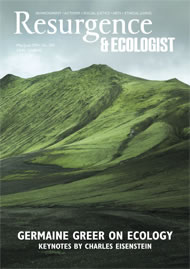One of the world’s leading thinkers on environment, development and sustainability has been brought to book. Again. (He has written dozens.) But this book is focused on him, rather than simply on the rest of the world and its future. But beware: once you’re in, it’s compulsive reading.
Let’s keep it a secret between ourselves, but the copy of Lester Brown’s autobiography that the Resurgence team sent me to review opens with a handwritten dedication from the author to the magazine’s editor, Satish Kumar, thanking him for his support over the years. Satish can have the book back if he asks really nicely, but he’ll find that I’ve annotated it fairly heavily throughout, something I rarely do.
So why did I take that liberty? For one thing, while this isn’t quite the environmental version of Being John Malkovich, there was the sheer joy of being given a set of keys to the mind of one of the most influential people of the past half-century. I read the book cover-to-cover in a couple of sittings and learned an immense amount in the process, not just about Brown’s extraordinary life and times but also about the mind-boggling spectrum of challenges he has taken on.
It has been my privilege to meet Brown several times, when he was at the Worldwatch Institute and more recently at the Earth Policy Institute. And he is one of very few people who I can honestly say has been a beacon; a living navigational reference point, throughout my own 40-year career. Then, in addition to the cornucopia of agenda-shaping books and reports he has produced, there has been the steady flow of talent honed by early years spent at the organisations he founded, among them Erik Eckholm, Christopher Flavin, Denis Hayes and Sandra Postel.
In some ways, though, the story starts in 1820, when Colonel Robert Gibbon Johnson stood on the steps of the country courthouse in Salem, New Jersey. There he publicly ate a tomato – or “love apple” – in front of an anxious crowd. Considered poisonous at the time, the tomato subsequently became a staple product of the state’s economy. As Brown notes, that legend was popular where he grew up, on a small farm near Salem, but tomatoes had been eaten in places like Spain and Italy since the 1500s. The link is that, while still at school, he and his brother had launched a staggeringly successful operation that by 1958 was producing 1.5 million pounds of tomatoes.
Unlike Forest Gump, who somehow inserts himself into defining moments in our collective history, Lester Brown was a participant, a player, in many landmark events, from the launch of the Limits to Growth study in 1972 to a blur of Earth Summits, World Economic Forums and even more dramatic behind-the-scenes meetings. His series of reports – particularly under the State of the World, Vital Signs and Plan B brands – have been crucial stepping stones for those of us who have worked to push the sustainability agenda into the heart of politics, government, business and finance.
A key chapter deals with the repercussions of Brown’s 1994 article Who will Feed China? Although initial publication in World Watch magazine attracted only modest attention, when reprinted in the Washington Post it triggered “a political firestorm in Beijing”. But how typical of Brown’s extraordinary life trajectory that by 2006, when he met Chinese Premier Wen Jiabao, the first thing Wen said was, “Your book was very helpful to us.” It would be an understatement for the rest of us to say the same of Brown’s work. Read this book – and let’s hope for a sequel.







